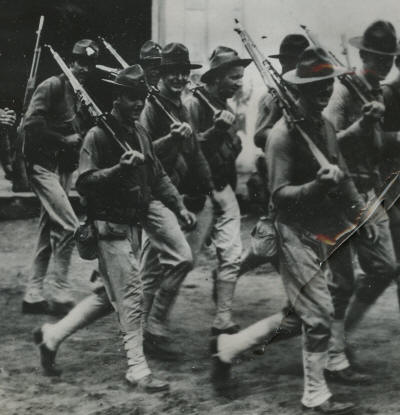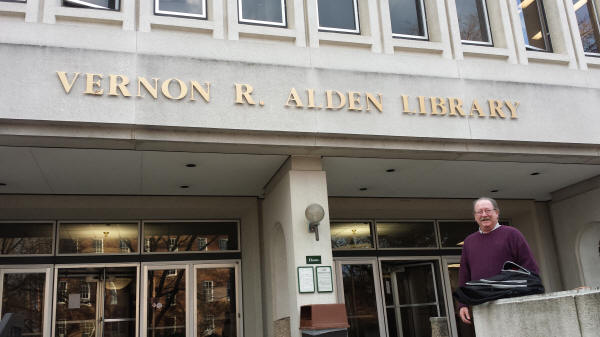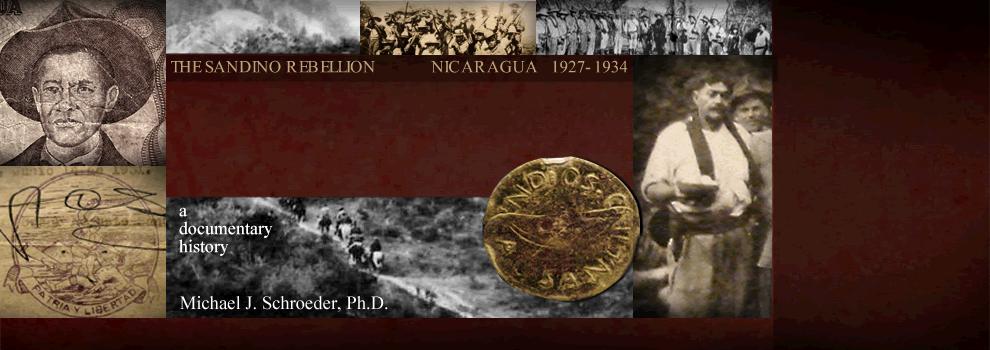|
 THIS
IS THE FIRST OF FIVE WEB PAGES
dedicated to the personal
letters of Private First Class Emil "Porter" Thomas
of
Cleveland, Ohio to his fiancée Beatrice before, during, and
after the year he was stationed in Nicaragua (April 1928—March
1929). The
original letters are housed in Alden Library of Ohio University
in Athens, Ohio. I thank Alden Library for its kind
permission to publish these letters here. All text and
images of the letters © Alden Library. (Right: US Marines fresh off the
USS Mississippi marching north from León to
supervise the November 1928 elections, much as Emil Thomas did
in April 1928. From the US National Archives; see
PHOTO-DOCS USNA2 PAGE
18 PHOTO 6
).
THIS
IS THE FIRST OF FIVE WEB PAGES
dedicated to the personal
letters of Private First Class Emil "Porter" Thomas
of
Cleveland, Ohio to his fiancée Beatrice before, during, and
after the year he was stationed in Nicaragua (April 1928—March
1929). The
original letters are housed in Alden Library of Ohio University
in Athens, Ohio. I thank Alden Library for its kind
permission to publish these letters here. All text and
images of the letters © Alden Library. (Right: US Marines fresh off the
USS Mississippi marching north from León to
supervise the November 1928 elections, much as Emil Thomas did
in April 1928. From the US National Archives; see
PHOTO-DOCS USNA2 PAGE
18 PHOTO 6
).
The entire collection houses some 331 letters, comprising some
186,000 words, spanning a period of nearly four years (September
1925 to July 1929).
This homepage offers a critical introduction to
the letters and the contexts of their production.
Pages 2 and 3
house the first 202 letters, most all written from the Marine
base in Quantico VA.
Page 4 houses the next 73 letters,
written in Nicaragua.
Page 5 houses the last 56 letters,
written after his return from Nicaragua.
I thank
Thomas W. Walker
for alerting me to the existence of these letters, and
especially
Douglas McCabe
of the Mahn Center for Archives and Special Collections of Alden
Library for his kind assistance during my research, including
sharing the Library's transcription of every one of the
collection's 331-some letters. I am also indebted to the
Dick Joyce Endowment at Lebanon Valley College for the financial
assistance that made this research possible.
The remainder of this Homepage for the Emil "Porter"
Thomas Letters
is divided into three parts:
1. Links to PDF files of the entire collection.
2. Background information Emil Thomas, his family,
and his relationship to Beatrice.
3. Critical reflections on interpreting this mass
of material.
1. The
Entire Collection in PDF Files.
The entire collection is accessible via the following two PDF
files: for the original transcription kindly provided by
Douglas McCabe, without any alterations, click
HERE.
For a slightly revised transcription that dispenses with the
filing information, reformats a bit, and makes each letter
slightly easier to identify by date, click
HERE.
2.
Background Information on Emil Thomas, His Family, and His
Relationship to Beatrice.
Emil “Porter” Thomas was born on 23 April 1906 in
Cleveland, Ohio, the son of Hungarian immigrants Paul and
Pauline Thomas. In Cleveland he attended West Technical
High School, where in the ninth grade he met Beatrice Keeran (b.
Dec. 1908). After graduating from West Tech High, in June
1925 at age 19, he enlisted in the U.S. Marine Corps, where he
served for four years until his honorable discharge in July
1929. Most of his military service he spent at the Marine
Corps base in Quantico, VA. On a brief tropical tour to
Panama in 1925, he returned to Quantico where he began writing
letters to Beatrice in an effort to win her hand in marriage; in
mid-1926, she agreed, and the letter-writing courtship
continued.
In March 1928 he shipped off to Nicaragua
aboard the USS Oglala (61st Machine Gun Company, 11th
Regiment), part of a larger Marine Corps detachment supervising
the November 1928 elections that brought to power the Liberal
General José María Moncada. Setting foot in Nicaragua for
the first time on April 1, 1928, he was in the country for 12
months, departing in early March, 1929. In Nicaragua, he
was stationed in León and Managua (April—June), Ocotal (8
July—14 September), and Telpaneca (14 September—4 November),
where he served as “vice president” (suplente) for the
Telpaneca electoral mesa. After the November elections, he
returned to Ocotal. From January to March 1929, he served
with the Voluntario forces mobilized by President
Moncada to fight “banditry” in the northern mountains, where he
had numerous "contacts" (military encounters) with the
Sandinista rebels.
3.
Critical Reflections on Interpreting the Emil "Porter" Thomas Letters
Anyone who has traveled away from loved ones for an
extended period of time and written letters back home should
find many deep resonances in this massive collection of personal
letters. First and foremost, these letters represent an
extended courtship in a budding romance that Emil “Porter”
Thomas hoped would turn into a happy marriage with the object of
his desire, Beatrice. Anything beyond that primary purpose
are asides and fillers.
In
these 330-plus letters we see the full gamut of the author’s
emotions – sadness and longing, hope and happiness,
confusion and uncertainty, silliness and humor, aspirations and
desires. Like a well-developed character in a rich and complex
novel, they show Emil Thomas for the full human being he was –
his virtues and vices, his seemingly boundless capacity for
romantic love, his hopes and dreams, his frustrations and
accomplishments, and – most important for our purposes here –
his deeply internalized racism toward the “niggers” at home and
the “spicks” and “gooks” of the tropics.
We see a man devoted to his sweetheart, to the Marine
Corps, and to his fellow Marines, a man dedicated to
self-improvement in various spheres – an accomplished mechanic
and a talented musician (especially on the clarinet and violin).
We see him reading books, striving to educate himself, and
expanding his mind by taking classes on mathematics, civil
service, and other disciplines. We even see his penmanship
and command of the English language improve over the course of
his four years of letter-writing.
What makes this collection of letters so valuable for historians
is that their author never intended that they be read by anyone
other than his sweetheart Beatrice. Allowing readers to
see past the “official” discourse that saturates the “official”
documentary record, these letters offer an unprecedented window
on the raw, honest, unfiltered, often heart-wrenching
reflections and ruminations of a typical Marine Corps “grunt” in
Nicaragua at the height of the US occupation. The letters
comprise only one side of a two-way conversation, of course,
though we do catch many hints about what Beatrice was writing
back to him.
For a historian of Nicaragua, the most valuable
parts of these letters consist of Thomas’s observations about
the natives, their culture, their racial characteristics, and
their relationship to the US Marines. In a revealing linguistic
shift, Thomas writes from Quantico about the “niggers” in
Nicaragua. Once there, he realizes that Nicaraguans are “not
niggers” but “half-breeds”:
“These people here aren’t niggers honey. I thought they were
like in Haiti and Cuba but they aren’t. They are a mixture of
Spanish and Indian I don’t like them though and they hadn’t
better give me any reason at all to kill them cause I clean and
oil my pistol every morning and I need Half breed hide to make a
good suit case.” (April 1, 1928).
From this point, Thomas stops calling Nicaraguans
“niggers” and starts calling them “gooks,” a classic
racial epithet for Asians that he probably picked up from
veterans of the Marine Corps campaigns in China and the
Philippines. He uses the term dozens of times; e.g., September
3, 1928:
“When the news of the bandits got out we had lots of fun
watching the gooks clear the streets. They know better than to
stay out cause in a time like that we don’t stop at anything and
most of us are only to glad to have an excuse to bump off a few
gooks.”
There is no reason to suppose that Emil
Thomas’s views on race were atypical. Indeed, all the
evidence suggests that Emil "Porter" Thomas represented an
eminently typical white, working class young man growing up in
the highly racialized, anti-immigrant context of the 1910s and
1920s, and that his Marine Corps comrades fully shared his
racialized understanding of the world. In sum, the
voluminous letters of Emil Thomas's offer historians a rich,
fascinating, unfiltered, and highly revealing look at the
deep-seated racism and cultural arrogance that saturated Marine
Corps culture during this period.

Above: Douglas McCabe, Curator of Manuscripts, Arts &
Archives, at the front entrance to Alden Library, Ohio
University, Athens, Ohio, December 2014.
|

